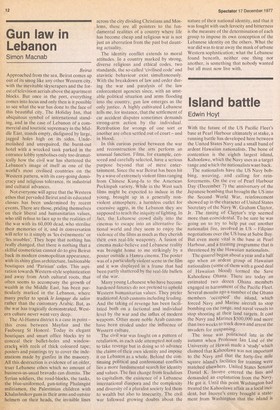Island battle
Edwin Hoyt
With the future of the US Pacific Fleet's base at Pearl Harbour ultimately at stake, a running battle has developed here between the United States Navy and a small band of ardent I lawaiiaii nationalists. The bone of contention is the eighth largest island, Kahoolawe, which the Navy uses as a target range and which the nationalists want back.
The nationalists have the US Navy bobbing, weaving, and calling for reinforcements. On the eve of Pearl Harbour Day (December 7) the anniversary of the Japanese bombing that brought the US into the Second World War, reinforcement showed up in the character of United States Secretary of the Navy W. Graham Claytor, Jr. The Aiming of Claytor's trip seemed more than coincidental. To be sure he was going on to try to help put out another nationalist fire, involved in US — Filipino negotiations over the US base at Subic Bay. But even more vital is the base at Pearl Harbour, and a training programme that is threatened by the Hawaiian nationalists.
The quarrel began about a year and a half ago when an ardent group of Hawaiian nationalists (some of them with a good deal of Hawaiian blood) formed the Save Kahoolawe Ohana. There are today an estimated two dozen Ohana members engaged in harassment of the Pacific Fleet. Several months ago a number of the Ohana members 'occupied' the island, which forced Navy and Marine aircraft to stop bombing on the range, and naval vessels to stop shooting at their land targets. It cost the Navy and Marines $500,000 and more than two weeks to track down and arrest the invaders for trespassing: The issue was politicised late in the autumn when .professor Ian Lind of the University of Hawaii made a 'study' which claimed that Kahoolawe was not important to the Navy and that the forty-five mile square island's facilities for training were matched elsewhere. United States Senator Daniel K. Inouye entered the lists and demanded an explanation from the Navy. He got it. Until this point Washington had treated the Kahoolawe affair as a local incident, but Inouye's entry brought a statement from Washington that the island Is vital to Navy training, and for the first time raised the spectre that the Pacific Fleet might be forced to move elsewhere.
The fleet includes eighteen warships which must fire for practice twice each year to maintain gunnery readiness. There are no other suitable sites for targets' in these islands, or any closer than San Clemente island, off the US coast and 2,500 miles from Hawaii. The Navy has pointed out that it would take twelve to fifteen extra days steaming time (Kahoolawe is only hours from Pearl Harbour) at $3,100 per day fuel cost per vessel, to use San Clemente island as a target. The implication is clear that, if the fleet had to undertake such a programme, it might be forced to move back to the mainland. That would mean the Marines would also probably relocate. And, if so, a third of Hawaii's economic base, which is the military presence, would be seriously threatened.
Actually Kahoolawe has never been a part of the State of Hawaii. The US government took title to the land in the annexation of 1898 and reserved it.. For a while the land was used as a ranch, but it was never satisfactory because it was uninhabited and had no water of its own. It was only in the 'forties that the fleet began to use the island for target practice. Since that time the Navy and Marines have poured enormous amounts of ordnance into the target ranges, and 10,000 tons remain unexploded mostly beneath the surface. The cost of removing that ordnance has been estimated in the hundreds of millions of dollars.
The Navy has good title to the property, so what is the shouting about? The basic problem is the emotional miasma which has enshrouded the entire issue, causing US District Judges to inveigh against the Navy, and Hawaiian nationalist opinion to reach hysterical pitch. The invaders who 'captured' the island were tried and sentenced to minor jail terms, and small fines. Several, who defied the authorities, actually did serve some time in jail. But concurrently one Federal judge ruled that the Navy would have to file annual environmental impact statements (EIS) on its use of Kahoolawe as a target. The Navy has complained that this move will erect a new mountain of paperwork. That's where it stands. The Ohana is seeking to broaden the issue, with claims about archaeological significance (a few fishing shrines have been unearthed) and the group continues to harangue the public. So the world is faced with the caricature of one of the two most powerful navies in the world under siege and threatened with immobilisation in a major base by some two dozen recalcitrant causists. If it were not so serious it would be an apt subject for a literary spoof on the order of The Mouse That Roared, or a Walt Disney movie. I saw Secretary Claytor at a press conference just after his arrival here. He looked unshaven and haggard, like a man who has been up all night. The contemplation of Kahoolawe probably didn't help him get any sleep.



































 Previous page
Previous page